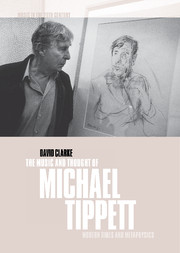Book contents
- Frontmatter
- Contents
- Acknowledgements
- References to Tippett's scores and essays
- 1 Tippett and the ‘world vision’ of modernity
- 2 The significance of the concept ‘image’ in Tippett's musical thought: a perspective from Jung
- 3 Back to Nietzsche? Transformations of the Dionysiac in The Midsummer Marriage and King Priam
- 4 Metaphysics in a cold climate: The Vision of Saint Augustine
- 5 ‘Shall we …? Affirm!’ The ironic and the sublime in The Mask of Time
- 6 The meaning of ‘lateness’: mediations of work, self and society in Tippett's Triple Concerto
- 7 The golden bird and the porcelain bowl: Byzantium and the politics of artefacts
- Notes
- Bibliography
- Index
3 - Back to Nietzsche? Transformations of the Dionysiac in The Midsummer Marriage and King Priam
Published online by Cambridge University Press: 13 October 2009
- Frontmatter
- Contents
- Acknowledgements
- References to Tippett's scores and essays
- 1 Tippett and the ‘world vision’ of modernity
- 2 The significance of the concept ‘image’ in Tippett's musical thought: a perspective from Jung
- 3 Back to Nietzsche? Transformations of the Dionysiac in The Midsummer Marriage and King Priam
- 4 Metaphysics in a cold climate: The Vision of Saint Augustine
- 5 ‘Shall we …? Affirm!’ The ironic and the sublime in The Mask of Time
- 6 The meaning of ‘lateness’: mediations of work, self and society in Tippett's Triple Concerto
- 7 The golden bird and the porcelain bowl: Byzantium and the politics of artefacts
- Notes
- Bibliography
- Index
Summary
The sense of an ending
The way a work ends can tell us much about its stylistic and aesthetic premises. In the case of Tippett's King Priam (1958–61) the last forty-five seconds encapsulate in both stage action and sound image the wave of brutality that has coursed through the entire opera. In fulfilment of the augury delivered in the very first scene Priam, the Trojan king, meets his death, run through on the avenging sword of Achilles' son, while around him the once-civilized city of Troy is now a blazing site of carnage. Just seven bars of music drive this last action – a gesture of utter compression. A sequence of colliding ostinati – pounding drum patterns, distorted brass fanfares and stylized shrieks in flutes, clarinets and upper strings – yields a saturation of pitches and intervals which renders every last atom of the musical structure dissonant. (And after: distilled from the silence of no more music, a shift of subjective vantage point: a few eerie sounds which might represent tears, our tears, Tippett tells us.)
How strikingly this contrasts with the close of Tippett's previous opera, The Midsummer Marriage (1946–52). Its final minute is suffused with the sonority of A major, exploding from a celebrative cymbal clash, like a sunburst, and finally subdued into gentle, blended orchestral hues reminiscent of the close of Wagner's Tristan. This sound grounds the dancing energy of all the other figuration and symbolizes the resolution of the oppositions and tensions of the entire opera.
- Type
- Chapter
- Information
- The Music and Thought of Michael TippettModern Times and Metaphysics, pp. 36 - 95Publisher: Cambridge University PressPrint publication year: 2001



